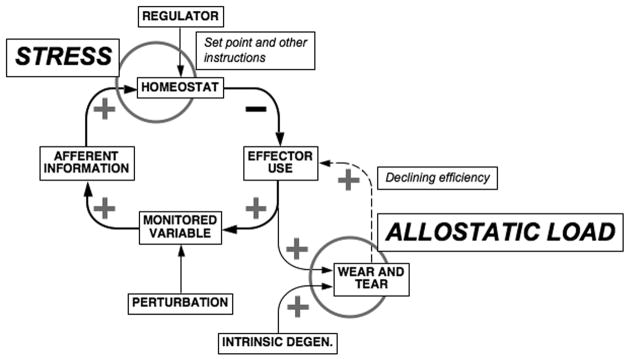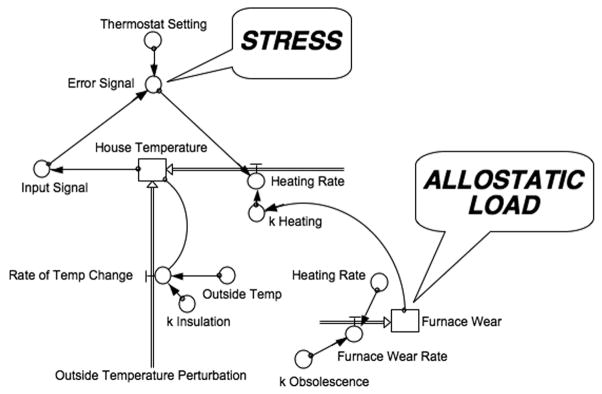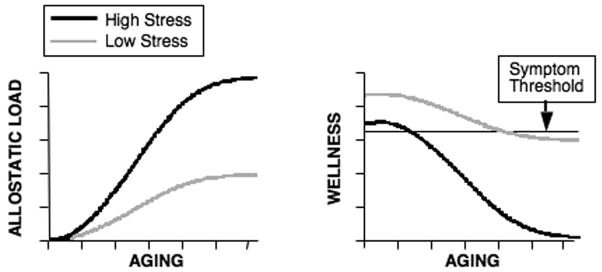Abstract
The past century has seen a profound shift in diseases of humankind. Acute, unifactorial diseases are being replaced increasingly by multifactorial disorders that arise from complex interactions among genes, environment, concurrent morbidities and treatments, and time. According to the concept of allostasis, there is no single, ideal set of steady-state conditions in life. Allostasis reflects active, adaptive processes that maintain apparent steady states, via multiple, interacting effectors regulated by homeostatic comparators “homeostats.” Stress can be defined as a condition or state in which a sensed discrepancy between afferent information and a setpoint for response leads to activation of effectors, reducing the discrepancy. “Allostatic load” refers to the consequences of sustained or repeated activation of mediators of allostasis. From the analogy of a home temperature control system, the temperature can be maintained at any of a variety of levels (allostatic states) by multiple means (effectors), regulated by a comparator thermostat (homeostat). Stress might exert adverse health consequences via allostatic load. This presentation describes models of homeostatic systems that incorporate negative feedback regulation, multiple effectors, effector sharing, environmental influences, intrinsic obsolescence, and destabilizing positive feedback loops. These models can be used to predict effects of environmental and genetic alterations on allostatic load and therefore on the development of multi-system disorders and failures.
Keywords: stress, allostasis, catecholamines, homeostasis
INTRODUCTION
The great French physiologist, Claude Bernard, introduced the idea of the “inner world” of the body, when he theorized that body systems function as they do to maintain a constant internal environment what he called the milieu interieur. Near the end of his life, in about 1876, he postulated that the body maintains the constant internal environment by myriad, continual, compensatory reactions, which would tend to restore a state of equilibrium in response to any outside changes, enabling independence from the external environment. Bernard’s Lectures on the Phenomena of Life Common to Animals and Vegetables (Vol. 1, translated by Hoff HE, Guillemin R, Guillemin L, Springfield, IL: Charles C Thomas Publisher, 1974) contains famous passages in the history of physiology: “The constancy of the internal environment is the condition for free and independent life” (p. 84), and: “All the vital mechanisms, however varied they might be, always have one purpose, that of maintaining the integrity of the conditions of life within the internal environment” (p. 89). This view might seem straightforward or even simple minded today, but it was revolutionary in the history of medical ideas.
Bernard’s views sometimes conflicted with those of his contemporary, Louis Pasteur, the father of microbiology and the germ theory of disease. According to Pasteur’s followers, diseases would result mainly from external threats to the well-being of the organism, such as exposure to germs; the body’s responses would be relatively unimportant. According to Bernard’s followers, diseases would result from inappropriate or inadequate responses of the body; the actual threats would be relatively unimportant. To paraphrase the great physician, William Osler, the debate was over whether disease is caused by the “seed” or caused by the “soil.”
During the era of ascendance of the germ theory of disease, at the end of the 1800s, the importance of the equilibrium of the organism receded; but now, with increasing recognition that diseases often stem from deleterious interactions between heredity and environment, or from genetic flaws outright, Bernard seems vindicated. Pasteur on his deathbed is said to have conceded, “Bernard was right. The microbe is nothing: the soil is everything.”
Inside every person is an inner world, full of comings and goings and the beautiful paradox of seeming constancy despite continuous change. We are born, we develop and mature, we reproduce, we live out our lives, we get old, we get sick, and we die, yet for most of our existence we believe in our essential sameness day to day.
For most of the amazing longevity that characterizes us humans, we rarely notice the internal workings that constitute the political affairs of the inner world. Cells of the body “turn over” we literally replace ourselves over time yet things inside seem to stay in a steady state so well, for so long. Body temperature, blood levels of key fuels, concentrations of red blood cells in the bloodstream, amounts of electrolytes, the rate of the heartbeat, blood flows to organs, and many more “variables” normally vary by remarkably little.
These steady states do not happen by chance. In higher organisms, they depend on complex coordination by the brain. This chapter introduces a way of thinking about how the brain regulates the inner world, to maintain apparent constancy despite continual changes.
In a single word, the brain does so via systems. Just as the brain receives information from sense organs about and determines our interactions with the outside world, the brain also receives information from internal sensors and acts on that information to regulate the inner world. For most of our lives we can cling to our belief in sameness only because the brain tracks many monitored variables, by way of internal sensory information, and acts on this information to maintain levels of monitored variables at controlled, steady values by modulating numerous effectors that work simultaneously, in parallel.
Scientific integrative medicine is not a treatment method or discipline but a way of thinking that applies systems concepts to understand acute and chronic complex disorders.1
Scientific integrative medicine builds on systems biology but is also distinct in several ways: (1) Scientific integrative medicine recognizes that in higher organisms, including us humans, the brain dominates regulation of the “inner world” of the body. The brain regulates the many internal monitored variables of the body in parallel analogous to a computer’s multitasking. (2) The brain has plasticity, enabling modifications in algorithms for cellular, tissue, organ, and systemic processes. According to the concept of allostasis, set points and other elements of these algorithms vary, depending on recollections, sensations, and anticipations by the brain. (3) Scientific integrative medicine is medical, its overall mission to understand and rationally treat disorders and diseases. Clinicians rarely cure; rather, they manage, in particular by exploiting negative feedback loops and attempting to forestall or counter positive feedback loops. (4) The medications and treatments clinicians prescribe interact with their patients’ internal systems. Multiple, simultaneous degenerations, combined with multiple effects of multiple drugs and remedies, and myriad interactions between the degenerations and the treatments, constitute the bulk of modern medical practice. The scientific integrative medicine approach provides a framework for understanding highly complex and dynamic challenges to our integrity as organisms.
Characteristics of Homeostatic Systems
Negative Feedback Regulation
Levels of multiple monitored variables are kept stable by negative feedback loops.2 By analogy to a home heating system, a decrease in outside temperature would lead to a decrease in inside temperature, but for the thermostat directing the furnace to turn on (Figures 1 and 2). A (-) sign indicates a negative relationship.
Figure 1.
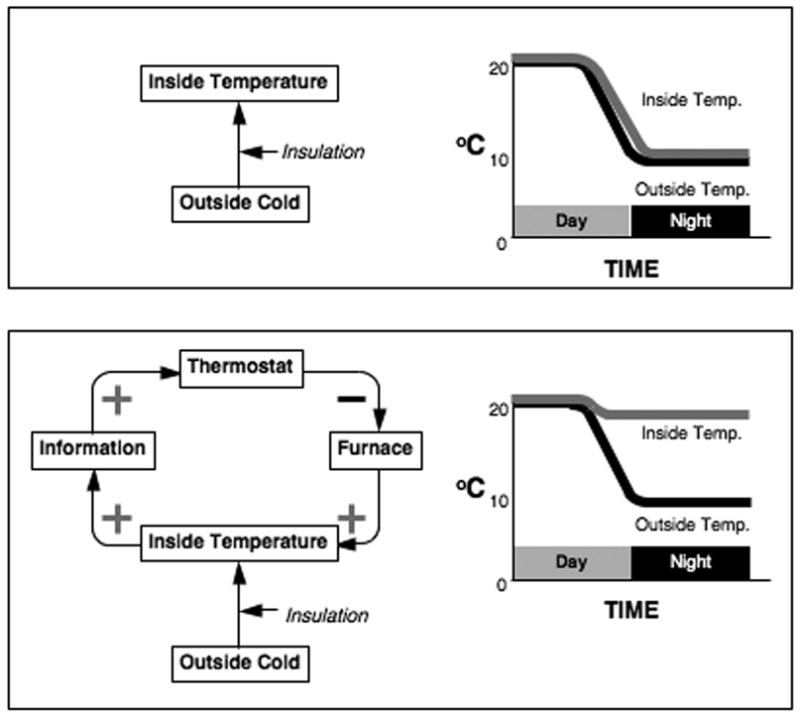
In the absence of a thermostatic system, as the outside temperature changes, the inside temperature also changes, depending on the insulation. With a thermostatic system, when a decrease in outside temperature leads to a sensed decrease in inside temperature that falls below the thermostatic set point, the furnace turns on, increasing the inside temperature. The inside temperature reaches an apparent steady state, due to the negative feedback loop.
Figure 2.
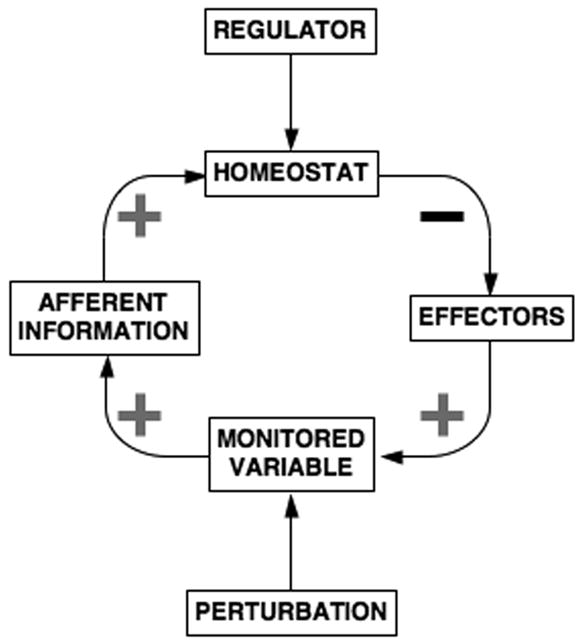
A physiological homeostatic system. As the level of the monitored variable changes, afferent information is compared with a set point or other algorithm for responding, and the sensed discrepancy leads to altered activities of effectors. Note the odd number of (-) signs, indicating a negative feedback loop. In response to a continuous perturbation, the level of the monitored variable reaches an apparent steady state.
If a homeostatic loop has an odd number of (-) signs, then during exposure to a continuous perturbing influence, the monitored variable will attain a stable level. Physiological homeostatic systems entail negative feedback regulation of monitored variables, such as core temperature, blood pressure, serum osmolality, and metabolic rate. Conceptually, each system depends on a comparator a homeostat to compare afferent information about the monitored variables with set points or other criteria for responding.
Disruption of a negative feedback loop, whether by preventing afferent information from reaching the brain, inability to process the information and regulate effector functions correctly, or dysfunction or loss of effectors, leads to fluctuations in the level of the monitored variable. A clinical example of this phenomenon is labile blood pressure as a late sequela of neck irradiation, due to interference with the carotid sinus baroreflex.
Multiple Effectors
The key monitored variables of the body are regulated by multiple effectors (Figure 3). This extends the range of control, allows some regulation of the monitored variable if a particular effector fails, via compensatory activation, improves cost efficiency, and enables elaboration of specific effector patterns. For instance, the sympathetic noradrenergic system (SNS), adrenomedullary hormonal system (AHS), and hypothalamic-pituitary-thyroid axis (THY) are effectors for regulation of core temperature. Hypophysectomy, thyroidectomy, and hypothyroidism are all associated with compensatory activation of the SNS. Because of compensatory activation, exposure of a thyroidectomized individual to cold results in exaggerated SNS activation.
Figure 3.

Compensatory activation. One advantage of multiple effectors is compensatory activation of alternative effectors if one effector fails, enabling control of the monitored variable. For instance, thyroidectomy augments sympathetic nervous system (SNS) responses to cold exposure. The left panel illustrates that in a homeostatic system involving two effectors (Eff. 1 and Eff. 2), inactivation of one effector leads to activation of the other. The right panel illustrates that in the homeostatic system for core temperature (Core Temp.) regulation, inactivation of the thyroid (THY) effector compensatorily activates the SNS effector.
Effector Sharing
An air conditioner not only cools the air but also dries it, and a dehumidifier not only dries the air but also warms it. An air conditioner and a dehumidified can therefore function as shared effectors for both temperature and humidity control. Analogously, different physiological homeostats can share effectors (Figure 4). Effector sharing can explain hyperglycemia in gastrointestinal hemorrhage and, as illustrated in the Figure, hyponatremia in congestive heart failure.
Figure 4.
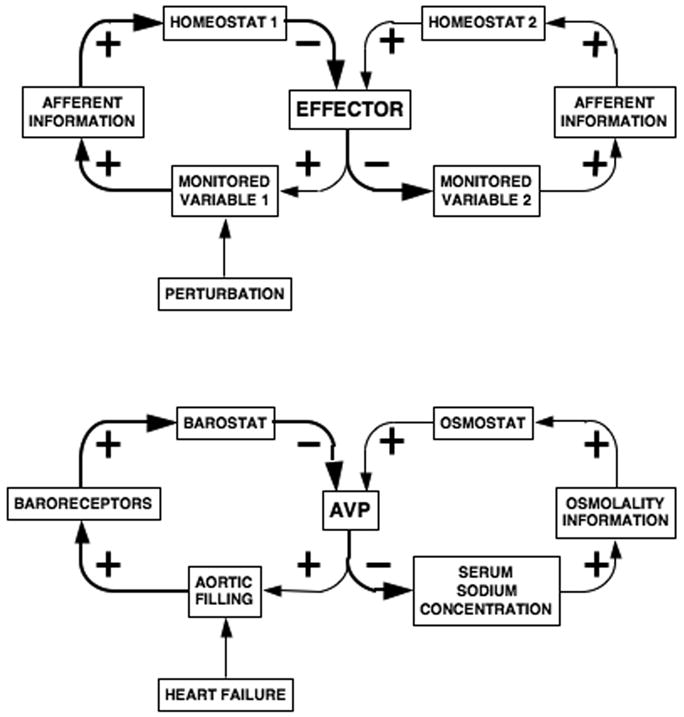
Effector sharing. Sharing of an effector by multiple homeostats can explain unpredicted consequences and syndromic features of disease processes. For instance, in heart failure, decreased aortic filling increases levels of vasopressin (AVP), which, as the anti-diuretic hormone, promotes retention of free water, explaining hyponatremia attending heart failure.
Homeostatic Definitions of Stress, Allostasis, and Allostatic Load3
In physiological homeostatic loops regulated by negative feedback, stress is a condition in which there is an error signal, reflecting the difference between afferent information about actual conditions as sensed and the set point for responding, determined by a regulator (Figure 5).
Figure 5.
Homeostatic definitions of stress and allostatic load. In stress the organism senses a discrepancy between afferent information about a monitored variable and a set point and other instructions for responding, altering activities of effectors to decrease the discrepancy. Allostatic load reflects wear and tear, which, if sustained and substantial enough, decreases effector efficiency, further activating the effector and accelerating wear and tear. Allostatic load can therefore eventuate in a destabilizing and pathologic positive feedback loop.
Although levels of monitored variables in a system regulated by negative feedback attain apparent steady-states, the actual level of the monitored variable can be adjusted, by changing the set point or other instructions for responding. Allostasis refers to this “other sameness.” This flexibility comes at the cost of wear and tear allostatic load (Figure 5). For instance, one can set the thermostat at a high temperature in the winter. Maintaining the high temperature at an apparent steady state accelerates wear and tear on the furnace. Moreover, as wear and tear progresses, furnace efficiency declines, requiring it to be on more of the time to maintain the temperature, in turn accelerating the wear and tear on the furnace. In other words, allostatic load can lead eventually to a positive feedback loop, with rapid failure of the system.
METHODS
Computerized kinetic models to illustrate the above concepts and to produce quantitative predictions can be generated using Stella II (isee Systems, Inc., Lebanon, NH), an icon-based model-building and simulation tool. Briefly, Stella models consist of “stocks,” represented by a rectangle, “flows” among them, represented by conduit pipes with transparent arrowheads in the direction of positive flow, and valve-like flow regulators determining the flow rate (Figure 6).
Figure 6.
Computer model of a thermostatic system and loci of stress (the Error Signal) and allostatic load. This model is designed to mirror the system for regulating house temperature shown diagrammatically in Figure 5. As outside temperature changes, the house temperature changes, since the insulation is imperfect. The thermostat senses a discrepancy (Error Signal) between the sensed and set temperatures. The Error Signal (corresponding to a state of stress) is a determinant of whether the furnace turns on. Depending on the efficiency of the furnace (k Heating), the house temperature returns toward the set value. The heating rate, along with planned obsolescence, also contributes to wear and tear on the furnace (allostatic load), which in turn decreases the efficiency of the furnace, and the decreased efficiency leads to a greater period of time when the furnace is on. A positive feedback loop ensues, resulting eventually in failure of the system for controlling house temperature.
RESULTS
Computer Models of Stress, Allostasis, and Allostatic Load
Computer models can generate predictions about effects of stress and allostatic load on levels of physiological monitored variables (Figure 6). By taking into account relatively straightforward principles such as negative feedback regulation, multiple effectors, effector sharing, and homeostat resetting, one can model complex, multi-system disorders.
In the depicted model (in this case of internal temperature), in response to a continuous perturbation, the error signal drives the effector (in this case the furnace), and actions of the effector alter the level of monitored variable in a direction opposite to the perturbation. The model therefore predicts a change in the level of the monitored variable in the direction of the perturbation, with a new apparent steady state attained that depends on the instructions to the effector and the efficiency of the effector. In the home heating model, stress is identical to the error signal driving the furnace. It can be shown that if the error signal alone drives the furnace, the final inside temperature will be lower than the thermostatic setting, with the difference depending on the outside temperature. Addition of the integrated error signal as a second determinant of furnace heating rate results in inside temperature reaching the same stable level, regardless of outside temperature.
In the computer model, allostasis reflects the regulator changing the set point or other components of algorithms for responding. For the same continuous perturbation, the amount of change in effector activation then depends on the change in the error signal, and the change in the error signal in turn depends on the change in the allostatic setting.
Allostatic load in the model reflects long-term effects of allostasis. The amount of wear and tear on the furnace would depend on intrinsic obsolescence and usage history. The usage history depends on the error signal over time. If allostatic load were large enough to decrease the furnace’s efficiency, this would set the stage for a positive feedback loop and rapid failure of the system.
Allostatic load links stress with degenerative diseases (Figure 7). Activation of effectors to counter threats to homeostasis produces wear and tear on the organs determining the level of the monitored variable and on the effectors themselves. Wear and tear, combined with planned obsolescence, decreases effector efficiency. The same perturbation then results in greater wear and tear and further decreases effector efficiency. Eventually, even with the effectors activated continuously, the monitored variable drifts from the allostatic setting. Finally, when the effectors fail, the organism can no longer mount a stress response at all.
Figure 7.
Model-predicted affects of stress and aging on allostatic load an on an individual’s wellness. According to the model, chronic stress can lead to sufficient allostatic load to eventuate in symptomatic disease as an individual ages.
DISCUSSION
In patients with chronic diseases of almost any sort, the inner world breaks down eventually; a key way this happens is by development of positive feedback loops. Heart failure stimulates the sympathetic nervous system and reninangiotensin-aldosterone system, which increases fluid retention, growth of heart muscle, and the work of the heart, worsening the heart failure. Chest pain from coronary ischemia evokes distress, stimulating the adrenomedullary hormonal system and increasing the rate of consumption of oxygen by the heart, worsening the ischemia. Orthostatic hypotension from failure of the sympathetic nervous system causes lightheadedness, a fall, fracture of a hip, and prolonged bed rest in traction, worsening the orthostatic hypotension when the patient tries to get up. A footballer practicing in full uniform in the heat releases adrenaline, which constricts skin blood vessels and augments heat production in the body, producing heat exhaustion, which releases more adrenaline, bringing on heat shock and death. Loss of dopamine terminals in the nigrostriatal system in the brain increases pathway traffic to the remaining terminals, accelerating dopamine turnover and thereby production of toxic by-products of dopamine metabolism, increasing the rate of loss of dopamine terminals, eventually manifesting clinically as Parkinson disease.
The timing and rapidity of system failure from positive feedback loops depend on dynamic interactions between usage experience of the system and built-in manufacturing and design characteristics. Analogously, in the body, the occurrence, timing, and rapidity of progression of degenerative diseases would depend on interactions between environmental exposures and genetic predispositions. The kinetic model of allostasis and allostatic load provides a nice framework for linking stress, distress, allostatic load, and degenerative diseases.
Consider diseases of senescence. Aging-related increases in susceptibilities to cardiovascular, neurological, oncological, and immunological diseases have always limited our lifespan and always will. One may search for rare genetic mutations causing premature degeneration. Alternatively, however, one may recognize that our bodies have been designed to protect and propagate genes, not to live indefinitely. Accordingly, one may hypothesize that groups of genes bias toward accelerated neuronal loss in the elderly because they enhance protection and propagation of genes in the younger reproducers. Perhaps the same homeostatic systems that organisms rely on to counter acute threats early in life cause senescence by the accumulation of toxic by-products of the actions of those systems.
For instance, parkinsonism in the elderly appears to result from cumulative injury to dopamine cells over the years. In the young, this enhanced release of dopamine might enable rapid initiation of locomotion or of other behaviors relevant to survival. Analogously, cardiovascular hypertrophy, and consequently susceptibility to stroke and heart failure in the elderly, could result from prolonged bombardment of adrenoceptors or continuous “rev-ing” of vesicular engines, enhancing adaptive fight-or-flight responses in the young at the cost of chronic changes in cardiovascular architecture.
This genetic-evolutionary perspective also leads to therapeutic hypotheses. If chronic production and metabolic breakdown of dopamine led to toxic injury to the cells, then long-term decrease in that breakdown in individuals with a genetically determined high rate could prolong the average useful life of human nervous systems. Analogously, disconnecting genetically determined hyper reactivity of catecholamine systems from chronic cardiovascular hypertrophy could prolong the average useful life of human circulatory systems.
Conclusion
As noted above, scientific integrative medicine focuses on prevention and treatment in the presymptomatic phase of organ dysfunction. The goal is to prevent positive feedback loops that would cause premature system failure. In general, it is in the pediatric age group that genetic or biochemical testing would have the greatest chance of success in revealing the existence of diseases before symptoms occur. If a patient had a mutation, a typo in the genetic encyclopedia, then correcting that typo with some form of gene therapy might make sense, as in gene therapy for adenine deaminase deficiency. If a patient had absent activity of an important enzyme, replacing that enzyme could work, as in enzyme replacement therapy for Gaucher disease. In a disease such as Menkes disease, prenatal or early neonatal biochemical diagnosis offers the only hope of survival, by initiation of treatment with copper. After the neonatal period, the baby is doomed, with or without the treatment.
For adult medicine, the future of clinical science is neither in molecular genetics nor in integrative pathophysiology but in building bridges between the two. Common, but complex, modern-day diseases will be found to be mainly disorders of regulation, only indirectly related to genetic changes. Most of the genetic contribution to disease in adults will be found to result not from direct genetic orders but from subtle genetic advice, which has afforded a survival advantage in evolution.
To the end, there is hope. In the presymptomatic, stable phase, there is hope of prevention. In the presymptomatic, unstable phase, there is hope of curative treatment. In the symptomatic, unstable phase, there is hope of alleviating symptoms. Even in the terminal phase, there is hope of allaying anxiety and distress, reducing pain, and offering commiseration.
A person’s genes link that person not only with his or her family, and not only with the family of man, but with all things that have ever lived. This surely is a basis for the fascination of genetics. As amazing as is the detail of the genetic instructions revealed by the Human Genome Project, we must now turn to the uses to which those instructions are put by living things to maintain organismic integrity so well for so long. The genes are life’s blueprint; ongoing information processing and compensatory adjustments enable life to go on. Scientific integrative medicine focuses on how that processing and those adjustments go awry and on means to predict and prevent premature system failures. The future development of scientific integrative medicine will require redirection of molecular genetics, molecular biology, and integrative physiology to focus on the real first causes of many modern diseases of adults: the loss of “wellness,” where both health and disease depend on genetic algorithms determining the development and adaptive regulation of homeostatic systems.
Conducting integrative medical research, especially in patients, is difficult. Studying one drug or one gene is always easier, cheaper, and more conclusive than studying more than one simultaneously. Studying the effects of a single gene knockout for an endogenous substance is always easier, cheaper, and more conclusive than studying the homeostatic systems that use that substance. Nevertheless, studying multiple homeostatic systems that operate in parallel and interact, according to influences of multiple genes, life experiences, drug treatments, and time, offers unique opportunities for early detection of presymptomatic system failure and optimal timing of interventions for prevention, cure, or effective treatment of chronic diseases of adults. Because of the availability of genomic information and computer software for database mining and kinetic modeling, the time seems ripe for development of scientific integrative medicine in research, teaching, and practice.
References
- 1.Goldstein DS. Adrenaline and the Inner World: An Introduction to Scientific Integrative Medicine. Baltimore, MD: The Johns Hopkins University Press; 2006. [Google Scholar]
- 2.Goldstein DS. Stress, Catecholamines, and Cardiovascular Disease. New York: Oxford University Press; 1995. [Google Scholar]
- 3.Goldstein DS, McEwen B. Allostasis, homeostats, and the nature of stress. Stress. 2002;5(1):55–58. doi: 10.1080/102538902900012345. [DOI] [PubMed] [Google Scholar]



